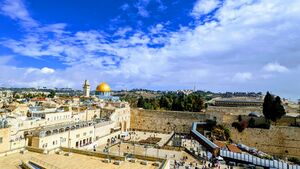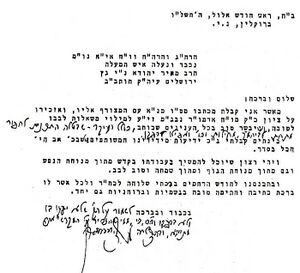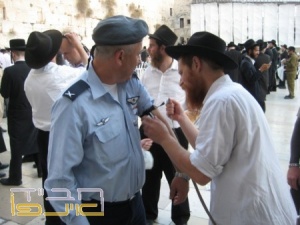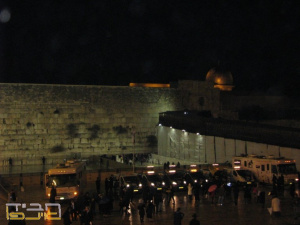The Western Wall

The Western Wall (in short: 'the Kotel'), is one of the four retaining walls surrounding the Temple Mount for about two thousand years, from the end of the Second Temple period until our days. The Western Wall has special holiness. The Wall is considered the second most important Jewish site in the world, after the Temple Mount. From this place onward begins the sanctity of the Holy Temple according to various levels.
"The Divine Presence has never departed from the western walls" - says the holy Zohar.

Sanctity of the House in the Present Time[edit | edit source]
The Rambam's opinion is that even today the punishment of karet applies because the first sanctification remains sanctified for the future as well. But the Raavad's opinion is that there is no punishment of karet today.
The Chasam Sofer writes that this dispute does not affect the matter of the supreme holiness that rests in the place of the Temple even in the present time according to all opinions, and the Divine Presence has not moved and will never move from the Western Wall, even in its destruction.

Prohibition of Inserting One's Hand Between the Stones of the Wall[edit | edit source]
It is forbidden for a tamei (ritually impure person) to enter the Temple Mount, therefore one should be careful not to insert one's hand between the stones of the Wall, since there are those who are tamei, such as zavim, zavot, niddot, and yoledot who are forbidden to enter the Temple Mount by a negative commandment. This also applies to someone who is not himself impure with these impurities, because even one who touches a zav - or a non-Jew whose status is rabbinically like a zav - or a niddah or yoledet, also becomes impure with the impurity of a zav, and the same applies to a baal keri. The prohibition also applies to inserting one's hand into the Wall, which some say is a Torah prohibition, because it is called in the language of the Sages "partial entry," and it is ruled that partial entry is considered entry, and there are those who disagree that it is a rabbinic prohibition and the punishment is makkat mardut (rabbinic lashes).
And the thickness of the wall of the Temple Mount has the sanctity of the Temple Mount, and its status is as if it is inside.
For one who is impure from contact with the dead, who knows for certain that he is not impure with any of the above impurities, there is no prohibition to enter the Temple Mount in general, except for certain places within the Temple Mount, some of which - from the Cheil and beyond - are forbidden by rabbinic decree, and some involve the punishment of karet. But since today we do not know the exact locations, all the great authorities of our generation have forbidden entry to the Temple Mount.
But it should be noted that regarding the general matter of whether the crevices between the stones are holy, there is a dispute among the poskim. The opinion of the Chazon Ish and other authorities is that there is a prohibition in this, and they wrote "woe to them and their souls," and there are those who permit it. Similarly, one should be careful when inserting notes into the stones of the Wall, lest one also insert one's fingers.
Place of Ascent of Prayers Through the Wall, or Through Hebron[edit | edit source]
In a conversation with Rabbi Shimon Nosson Nota Biderman of Lelov, the Rebbe raised a contradiction: The Mitteler Rebbe writes that prayers ascend through Hebron, and the wonder of it, since there is an explicit ruling in the Shulchan Aruch regarding prayer, that if one is standing outside the Land of Israel, one should turn one's face toward the Land of Israel, and if one is standing in the Land of Israel, one should turn one's face toward Jerusalem, as it is said, "And they shall pray to You through the city that You have chosen," and if one is standing in Jerusalem, one should turn one's face toward the Temple, as it is said, "And they shall pray toward this house."
Rabbi Shimon wanted to resolve that there might be a distinction between the time of the Temple and the present time, but the Rebbe rejected his words because the ruling is relevant even in the present time, and this is the practice both outside the Land of Israel to turn their faces toward the Land of Israel, and in the Land of Israel to turn their faces toward Jerusalem. Therefore, the Rebbe said that one must explain with difficulty that the prayers first reach Hebron and from there to Jerusalem, which has greater holiness.
During the conversation, Rabbi Shimon said in the name of his grandfather Rabbi David of Lelov that the Patriarchs are at the Western Wall on the eve of the holy Sabbath.
Regarding Rabbi Shimon's statement that Calev went to prostrate himself in Hebron, the Rebbe responded simply that it is possible that Hebron was on the path of the spies and therefore he went there, besides that this virtue of the graves of the Patriarchs exists specifically in Hebron.
The Frierdiker Rebbe's Visit to the Wall[edit | edit source]
The Frierdiker Rebbe (Rabbi Yosef Yitzchak Schneersohn), during his visit to the Land in 5689 (1929), visited the Wall. It was the day after his arrival in the country.
During the visit, a large crowd was present, and descriptions of the visit are found in the diary of Rabbi Shimon Glitzenstein:
At six o'clock, the figure of the Rebbe was seen approaching. His holy face glowed like fire, although from the outside no special signs of excitement were visible. Only the glowing face revealed that the Rebbe was 'burning' inside. Upon his arrival, the Rebbe tore 'kriah' in his outer garment.
Without wasting time, those present began the Mincha prayer. "Elijah was answered only in the Mincha prayer," and the Chassid R' Yosef Shmotkin led the prayers. It was a special prayer that left a deep impression on all those gathered. Even the Rebbe himself wrote in his diary that there was "great awakening like that of the eve of Yom Kippur."
In the silence and holy awe that prevailed among the gathered crowd, a quiet crying voice was heard coming from the depths of the heart. The entire crowd was shaken upon hearing the prayer of the tzaddik," wrote Rabbi Glitzenstein in his diary.
And the Rebbe - absorbed in his thoughts. Before his spiritual eyes stand his family members, as if standing together with him at that time, from afar yet from nearby, and praying together with him, pouring out their hearts each according to his understanding and according to his temperament and character, some in silence and some in thought, as if saying to the Master of the World - look and see and help us in all that we beseech You, Holy God. "Streams of tears of supplication opened for me," writes the Rebbe in his memories as he remembers his chassidim-disciples-beloved chassidim, they, their wives, and their children, who remained behind the Iron Curtain, downtrodden and exhausted. "And knowing that now at this time they are all remembering the holy place of the Temple, this aroused in me tears of blood, silent words, flashes of soul fire, and rays of hope to the Holy One, blessed be He, Himself, You Yourself, Master of the World, need to accept all the requests and fulfill the wishes for all good things.
At the end of the prayer, the Rebbe began reciting Psalms with a pleasant melody and wonderful devotion. Those gathered stood riveted to their places in prolonged anticipation not to miss even a single movement from that wonderful devotion.
When the Rebbe finished his prayer, he turned his head to those gathered around and asked whether it was customary to kiss these holy stones. After receiving an affirmative answer, "the Rebbe raised his eyes full of tears and expressing infinite sorrow over the expanses of the Western Wall, bowed his head, and the sound of the holy kiss on the remnant of our Temple was heard."
"In those few hours" - the Rebbe concludes - "I lived, I forgot about everything, I was a handbreadth higher, I tasted moments of life"...

Tefillin Campaign at the Western Wall[edit | edit source]

After the liberation of the Western Wall on the 28th of Iyar 5727 (1967), during the Six-Day War, Chabad Chassidim began putting on tefillin with visitors to the site, as part of the tefillin campaign announced by the Rebbe before the outbreak of the war.

Shortly thereafter, on the 21st of Sivan, a telegram arrived from the Rebbe's secretariat with the following instruction:
"The Rebbe Shlita's suggestion is to establish, if possible, a permanent booth by the Western Wall for putting on tefillin, naturally with permission from the appropriate authorities. It is worthwhile to print small-format tefillin blessings and Shema Yisrael prayers to distribute for free. Also, to sell checked tefillin there at a minimal price."
With the telegram—which arrived that same day—a more detailed letter was also sent from the secretary Rabbi Chaim Mordechai Eizik Hodakov, adding several instructions on the matter. Among other things, he wrote that even if currently there was no need for a special license to operate the tefillin booth, such a license should be obtained to prevent future complaints.
Upon receiving these instructions, Chabad Chassidim mobilized to fulfill them and operated a permanent tefillin booth. During the first days of its operation, the booth was staffed primarily by Chassidim from Kfar Chabad, under the management of Tzeirei Agudas Chabad headed by Rabbi Yisrael Leibov. However, a week later, a telegram was sent from the Rebbe to Tzeirei Chabad's Jerusalem branch, headed by Rabbi Tuvia Blau, in which the Rebbe wrote: "What has been done by Tzach and Anash of Jerusalem regarding the tefillin campaign? How many people have been involved and how many hours have they all dedicated to it together? Please telegraph details and names of participants—in an urgent letter, and obviously exaggeration in such matters is forbidden. Enough for the wise. Secretariat." Upon receiving the telegram, the Chassidim in Jerusalem were stirred to action on the matter, and they established a 'Tefillin Campaign Headquarters' that ensured the booth was staffed. The headquarters members included, besides Rabbi Blau, Rabbis: Ben Zion Sheinberger, Yehoshua Yuzvitch, and Yissachar Dov Wels.
A few months later, in the month of Tishrei, Rabbi Blau traveled to the Rebbe, and during the holiday meal on the second night of Sukkot in the Rebbe's presence, he was privileged to hear the Rebbe remark about him: "He manages the tefillin campaign at the Western Wall, and there tens of thousands have already put on tefillin." The Rebbe went on to explain the significance of the number 'revava' (ten thousand).
This booth has operated continuously until today and serves as a Chabad House in every respect. Since 5765 (2005), the booth has been managed by Rabbi Yosef Halperin and R' Shmuel Weiss.
The Rabbi of the Western Wall, Rabbi Shmuel Rabinowitz, is a Chabad Chassid.
Chabad events take place at the site such as: bar mitzvah for a thousand children organized by Colel Chabad, completion and dedication of Torah scrolls for the children of Israel.
See Also[edit | edit source]
- Temple Mount
- The Holy Temple
- Jerusalem Day
External Links[edit | edit source]
- Book "Remnant of Our Temple" about the Western Wall
- On the Rebbe's mission to the "Western Wall"
- Research on the authenticity of the Western Wall location
- Stunning gallery from the unfamiliar side of the Wall; the mysterious tunnels beneath the ground
- A thousand children at a bar mitzvah at the Western Wall
- Camp Oro Shel Moshiach parade at the Western Wall
- Video simulation - 770 facing the Western Wall
- Shlomo Riesel, The emissary in the most unexpected place in the world, a profile article about the Chabad House at the Western Wall
- How the Rebbe canceled the trip to him - for a visit to the Western Wall • Fascinating, on the website 'Moisture of Redemption'